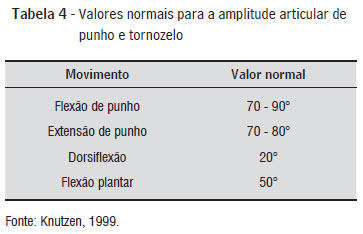INTRODUCTION: Type 2 diabetes (T2D) is a chronical disease with an important socioeconomic impact nowadays. Prevention, early detection and treatment are important to morbidity and mortality reduction. OBJECTIVES: To verify and compare the which have the greatest limitation of joint mobility (LJM), the LJM relation to age, the time of diagnosis of T2D, the presence of a prayer signal (PS), the risk neuropathic (RN) and the influence of exercises used in physiotherapy in elderly T2D and non T2D individuals. MATERIALS AND METHODS: The subjects were accomplished in three groups being control group (C; n = 15); T2D group (T2D; n=15) and T2D in physiotherapeutic treatment - stretching and light resistance exercises (T2DPhys; n = 15). Goniometry of the ankles and wrists, PS and RN were evaluated and the average of range of motion (ROM) was associated between groups accordingly to the age, time of diagnosis of T2D, PS and RN. RESULTS AND CONCLUSIONS: The average ROM in groups were C > T2DPhys > T2D, significantly (p < 0.05), except for right wrist flexion. There was a significant (p < 0.05) influence of physiotherapy (T2DPhys > T2D)in the wrist extension movement. The LJM were higher in older individual and in T2S with more time with disease but these relations were not significant. In this study, the RN and PS were not the only determinants of LJM. It was concluded that T2D interferes negatively and significantly in ROM and the physiotherapy treatment through stretching and resistance light exercises exerted beneficial influences on these parameters in the T2D.
Limitation of articular mobility; Diabetes mellitus; Elderly




